fuel pressure FIAT 500X 2019 Owner handbook (in English)
[x] Cancel search | Manufacturer: FIAT, Model Year: 2019, Model line: 500X, Model: FIAT 500X 2019Pages: 284, PDF Size: 8.33 MB
Page 56 of 284
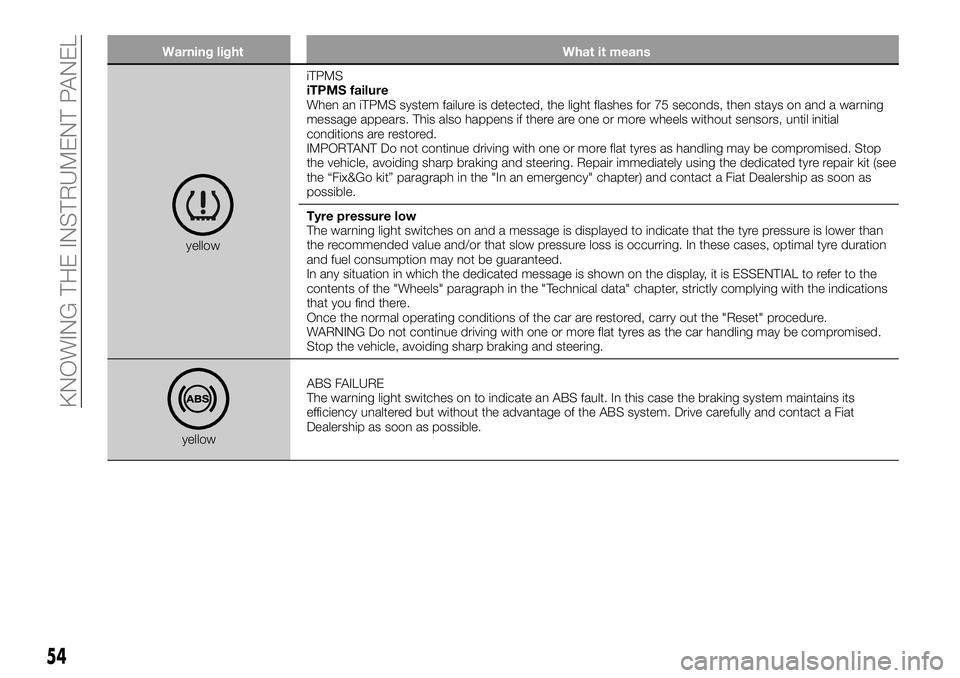
Warning light What it means
yellowiTPMS
iTPMS failure
When an iTPMS system failure is detected, the light flashes for 75 seconds, then stays on and a warning
message appears. This also happens if there are one or more wheels without sensors, until initial
conditions are restored.
IMPORTANT Do not continue driving with one or more flat tyres as handling may be compromised. Stop
the vehicle, avoiding sharp braking and steering. Repair immediately using the dedicated tyre repair kit (see
the “Fix&Go kit” paragraph in the "In an emergency" chapter) and contact a Fiat Dealership as soon as
possible.
Tyre pressure low
The warning light switches on and a message is displayed to indicate that the tyre pressure is lower than
the recommended value and/or that slow pressure loss is occurring. In these cases, optimal tyre duration
and fuel consumption may not be guaranteed.
In any situation in which the dedicated message is shown on the display, it is ESSENTIAL to refer to the
contents of the "Wheels" paragraph in the "Technical data" chapter, strictly complying with the indications
that you find there.
Once the normal operating conditions of the car are restored, carry out the "Reset" procedure.
WARNING Do not continue driving with one or more flat tyres as the car handling may be compromised.
Stop the vehicle, avoiding sharp braking and steering.
yellowABS FAILURE
The warning light switches on to indicate an ABS fault. In this case the braking system maintains its
efficiency unaltered but without the advantage of the ABS system. Drive carefully and contact a Fiat
Dealership as soon as possible.
54
KNOWING THE INSTRUMENT PANEL
Page 69 of 284
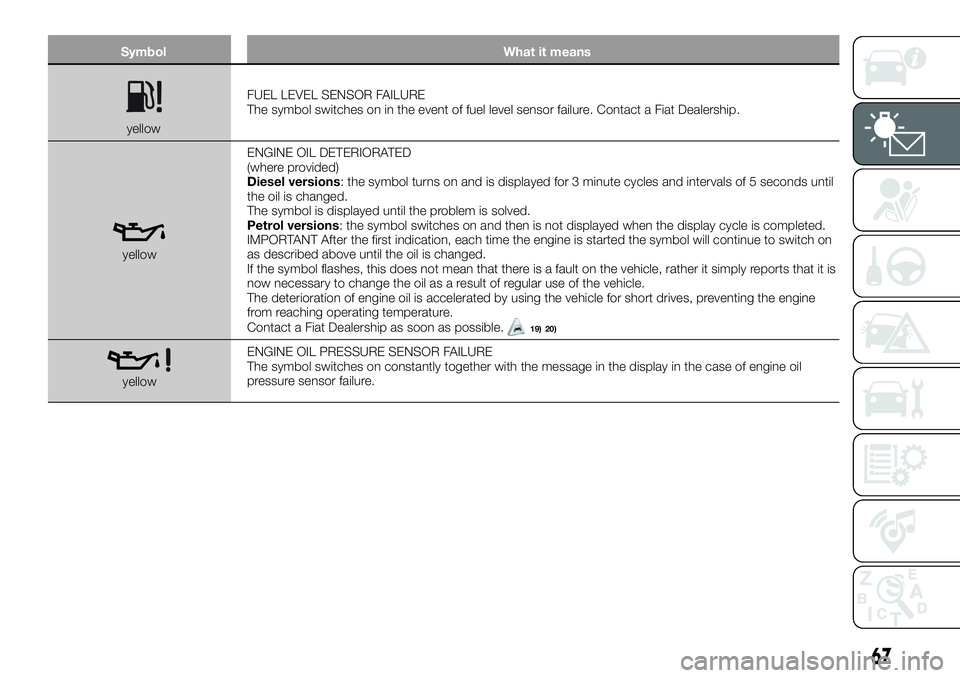
Symbol What it means
yellowFUEL LEVEL SENSOR FAILURE
The symbol switches on in the event of fuel level sensor failure. Contact a Fiat Dealership.
yellowENGINE OIL DETERIORATED
(where provided)
Diesel versions: the symbol turns on and is displayed for 3 minute cycles and intervals of 5 seconds until
the oil is changed.
The symbol is displayed until the problem is solved.
Petrol versions: the symbol switches on and then is not displayed when the display cycle is completed.
IMPORTANT After the first indication, each time the engine is started the symbol will continue to switch on
as described above until the oil is changed.
If the symbol flashes, this does not mean that there is a fault on the vehicle, rather it simply reports that it is
now necessary to change the oil as a result of regular use of the vehicle.
The deterioration of engine oil is accelerated by using the vehicle for short drives, preventing the engine
from reaching operating temperature.
Contact a Fiat Dealership as soon as possible.
19) 20)
yellowENGINE OIL PRESSURE SENSOR FAILURE
The symbol switches on constantly together with the message in the display in the case of engine oil
pressure sensor failure.
67
Page 89 of 284
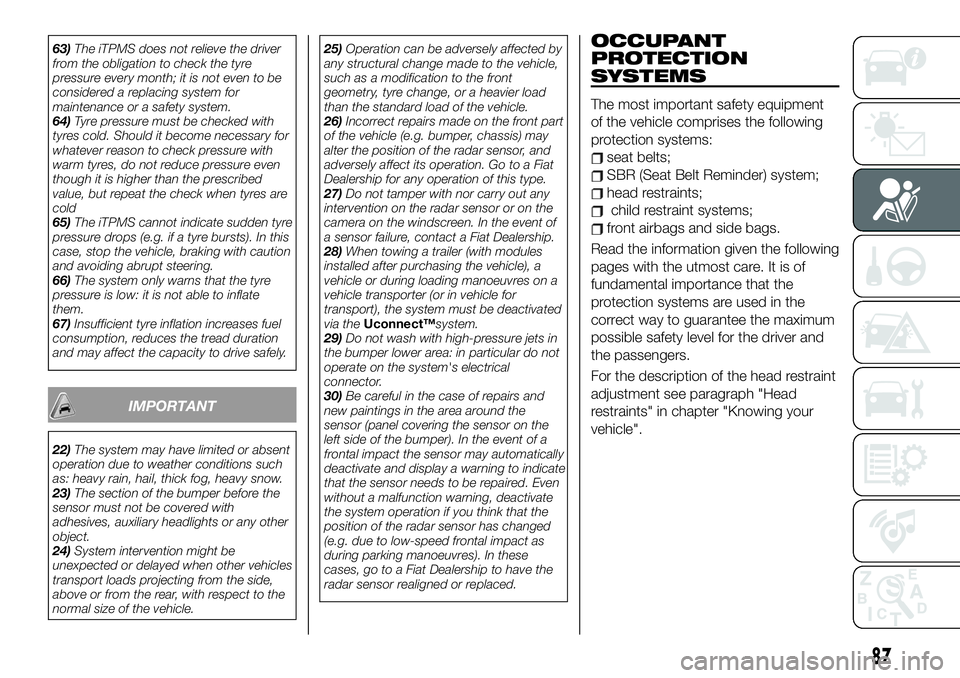
63)The iTPMS does not relieve the driver
from the obligation to check the tyre
pressure every month; it is not even to be
considered a replacing system for
maintenance or a safety system.
64)Tyre pressure must be checked with
tyres cold. Should it become necessary for
whatever reason to check pressure with
warm tyres, do not reduce pressure even
though it is higher than the prescribed
value, but repeat the check when tyres are
cold
65)The iTPMS cannot indicate sudden tyre
pressure drops (e.g. if a tyre bursts). In this
case, stop the vehicle, braking with caution
and avoiding abrupt steering.
66)The system only warns that the tyre
pressure is low: it is not able to inflate
them.
67)Insufficient tyre inflation increases fuel
consumption, reduces the tread duration
and may affect the capacity to drive safely.
IMPORTANT
22)The system may have limited or absent
operation due to weather conditions such
as: heavy rain, hail, thick fog, heavy snow.
23)The section of the bumper before the
sensor must not be covered with
adhesives, auxiliary headlights or any other
object.
24)System intervention might be
unexpected or delayed when other vehicles
transport loads projecting from the side,
above or from the rear, with respect to the
normal size of the vehicle.25)Operation can be adversely affected by
any structural change made to the vehicle,
such as a modification to the front
geometry, tyre change, or a heavier load
than the standard load of the vehicle.
26)Incorrect repairs made on the front part
of the vehicle (e.g. bumper, chassis) may
alter the position of the radar sensor, and
adversely affect its operation. Go to a Fiat
Dealership for any operation of this type.
27)Do not tamper with nor carry out any
intervention on the radar sensor or on the
camera on the windscreen. In the event of
a sensor failure, contact a Fiat Dealership.
28)When towing a trailer (with modules
installed after purchasing the vehicle), a
vehicle or during loading manoeuvres on a
vehicle transporter (or in vehicle for
transport), the system must be deactivated
via theUconnect™system.
29)Do not wash with high-pressure jets in
the bumper lower area: in particular do not
operate on the system's electrical
connector.
30)Be careful in the case of repairs and
new paintings in the area around the
sensor (panel covering the sensor on the
left side of the bumper). In the event of a
frontal impact the sensor may automatically
deactivate and display a warning to indicate
that the sensor needs to be repaired. Even
without a malfunction warning, deactivate
the system operation if you think that the
position of the radar sensor has changed
(e.g. due to low-speed frontal impact as
during parking manoeuvres). In these
cases, go to a Fiat Dealership to have the
radar sensor realigned or replaced.
OCCUPANT
PROTECTION
SYSTEMS
The most important safety equipment
of the vehicle comprises the following
protection systems:
seat belts;
SBR (Seat Belt Reminder) system;
head restraints;
child restraint systems;
front airbags and side bags.
Read the information given the following
pages with the utmost care. It is of
fundamental importance that the
protection systems are used in the
correct way to guarantee the maximum
possible safety level for the driver and
the passengers.
For the description of the head restraint
adjustment see paragraph "Head
restraints" in chapter "Knowing your
vehicle".
87
Page 152 of 284
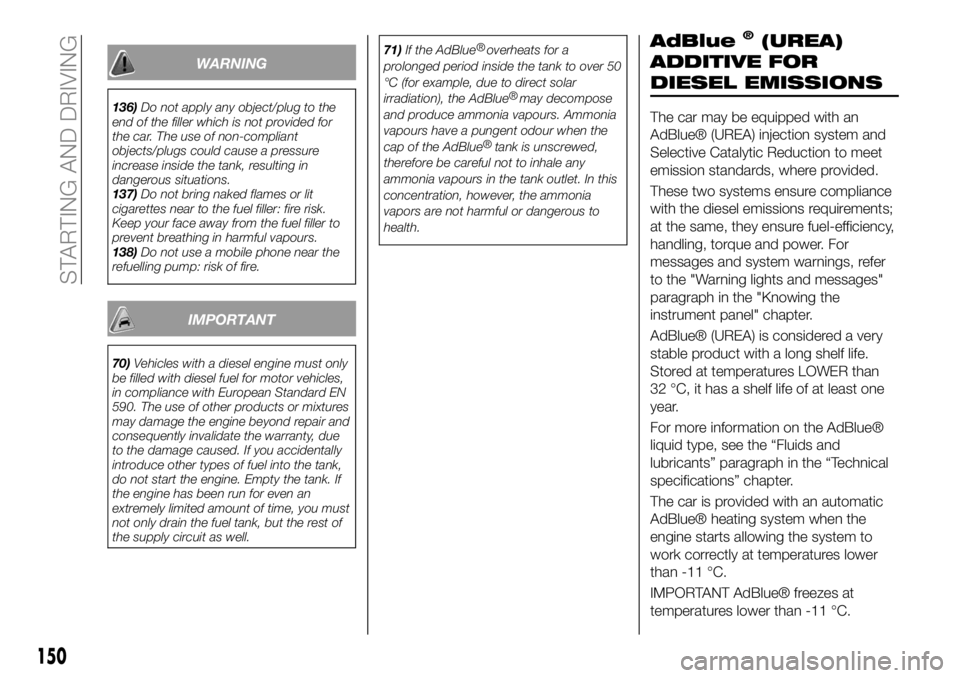
WARNING
136)Do not apply any object/plug to the
end of the filler which is not provided for
the car. The use of non-compliant
objects/plugs could cause a pressure
increase inside the tank, resulting in
dangerous situations.
137)Do not bring naked flames or lit
cigarettes near to the fuel filler: fire risk.
Keep your face away from the fuel filler to
prevent breathing in harmful vapours.
138)Do not use a mobile phone near the
refuelling pump: risk of fire.
IMPORTANT
70)Vehicles with a diesel engine must only
be filled with diesel fuel for motor vehicles,
in compliance with European Standard EN
590. The use of other products or mixtures
may damage the engine beyond repair and
consequently invalidate the warranty, due
to the damage caused. If you accidentally
introduce other types of fuel into the tank,
do not start the engine. Empty the tank. If
the engine has been run for even an
extremely limited amount of time, you must
not only drain the fuel tank, but the rest of
the supply circuit as well.71)If the
AdBlue®overheats for a
prolonged period inside the tank to over 50
°C (for example, due to direct solar
irradiation), the
AdBlue®may decompose
and produce ammonia vapours. Ammonia
vapours have a pungent odour when the
cap of the
AdBlue®tank is unscrewed,
therefore be careful not to inhale any
ammonia vapours in the tank outlet. In this
concentration, however, the ammonia
vapors are not harmful or dangerous to
health.
AdBlue®(UREA)
ADDITIVE FOR
DIESEL EMISSIONS
The car may be equipped with an
AdBlue® (UREA) injection system and
Selective Catalytic Reduction to meet
emission standards, where provided.
These two systems ensure compliance
with the diesel emissions requirements;
at the same, they ensure fuel-efficiency,
handling, torque and power. For
messages and system warnings, refer
to the "Warning lights and messages"
paragraph in the "Knowing the
instrument panel" chapter.
AdBlue® (UREA) is considered a very
stable product with a long shelf life.
Stored at temperatures LOWER than
32 °C, it has a shelf life of at least one
year.
For more information on the AdBlue®
liquid type, see the “Fluids and
lubricants” paragraph in the “Technical
specifications” chapter.
The car is provided with an automatic
AdBlue® heating system when the
engine starts allowing the system to
work correctly at temperatures lower
than -11 °C.
IMPORTANT AdBlue® freezes at
temperatures lower than -11 °C.
150
STARTING AND DRIVING
Page 182 of 284
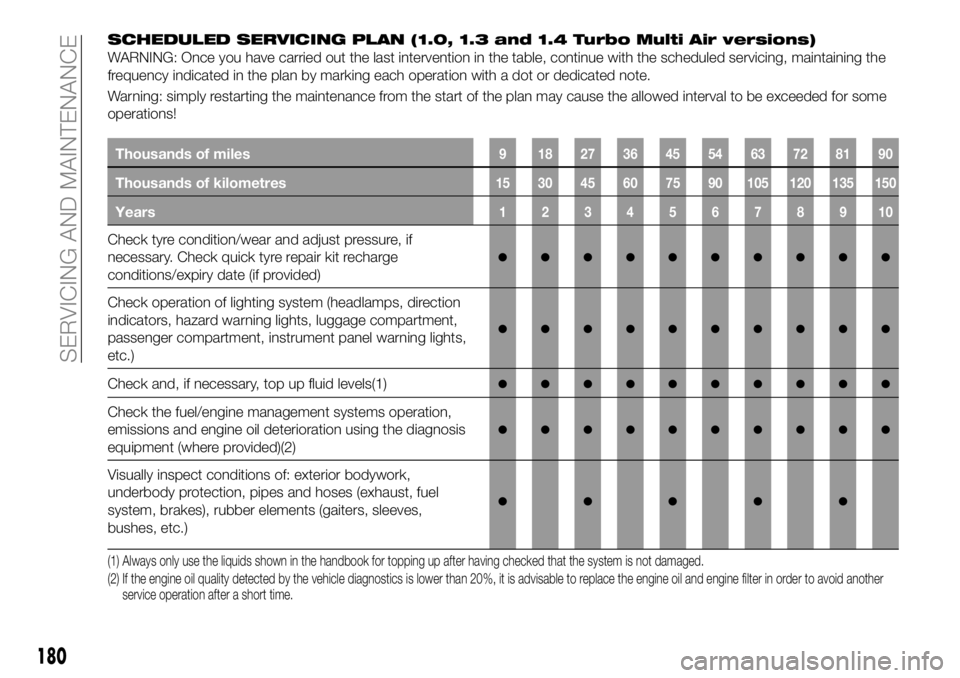
SCHEDULED SERVICING PLAN (1.0, 1.3 and 1.4 Turbo Multi Air versions)
WARNING: Once you have carried out the last intervention in the table, continue with the scheduled servicing, maintaining the
frequency indicated in the plan by marking each operation with a dot or dedicated note.
Warning: simply restarting the maintenance from the start of the plan may cause the allowed interval to be exceeded for some
operations!
Thousands of miles9 182736455463728190
Thousands of kilometres15 30 45 60 75 90 105 120 135 150
Years12345678910
Check tyre condition/wear and adjust pressure, if
necessary. Check quick tyre repair kit recharge
conditions/expiry date (if provided)
●●●●●●●●●●
Check operation of lighting system (headlamps, direction
indicators, hazard warning lights, luggage compartment,
passenger compartment, instrument panel warning lights,
etc.)
●●●●●●●●●●
Check and, if necessary, top up fluid levels(1)●●●●●●●●●●
Check the fuel/engine management systems operation,
emissions and engine oil deterioration using the diagnosis
equipment (where provided)(2)
●●●●●●●●●●
Visually inspect conditions of: exterior bodywork,
underbody protection, pipes and hoses (exhaust, fuel
system, brakes), rubber elements (gaiters, sleeves,
bushes, etc.)
●●●●●
(1) Always only use the liquids shown in the handbook for topping up after having checked that the system is not damaged.
(2) If the engine oil quality detected by the vehicle diagnostics is lower than 20%, it is advisable to replace the engine oil and engine filter in order to avoid another
service operation after a short time.
180
SERVICING AND MAINTENANCE
Page 186 of 284
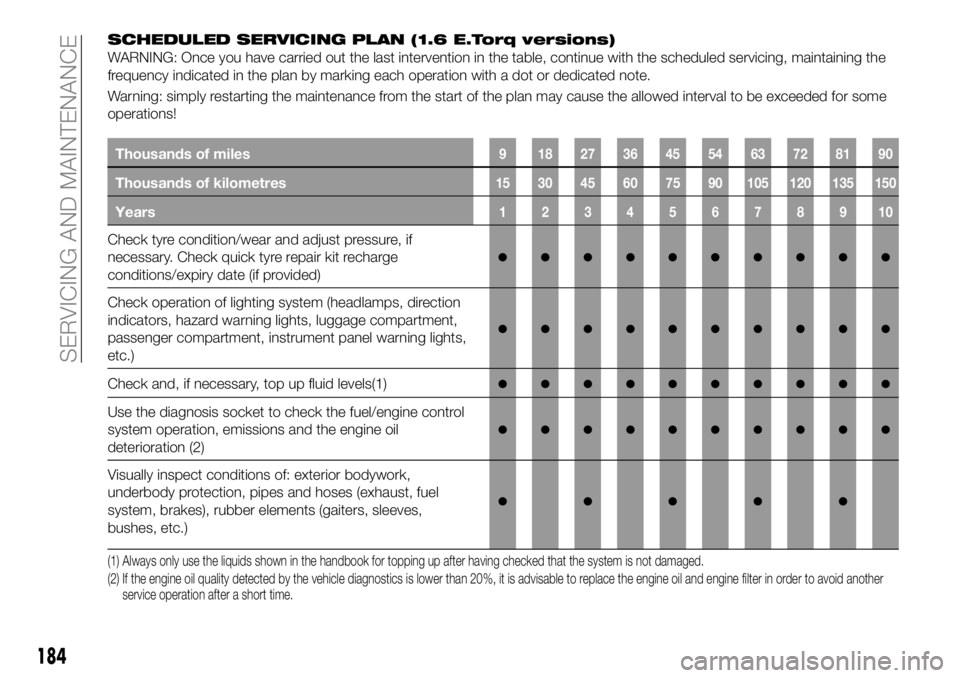
SCHEDULED SERVICING PLAN (1.6 E.Torq versions)
WARNING: Once you have carried out the last intervention in the table, continue with the scheduled servicing, maintaining the
frequency indicated in the plan by marking each operation with a dot or dedicated note.
Warning: simply restarting the maintenance from the start of the plan may cause the allowed interval to be exceeded for some
operations!
Thousands of miles9 182736455463728190
Thousands of kilometres15 30 45 60 75 90 105 120 135 150
Years12345678910
Check tyre condition/wear and adjust pressure, if
necessary. Check quick tyre repair kit recharge
conditions/expiry date (if provided)
●●●●●●●●●●
Check operation of lighting system (headlamps, direction
indicators, hazard warning lights, luggage compartment,
passenger compartment, instrument panel warning lights,
etc.)
●●●●●●●●●●
Check and, if necessary, top up fluid levels(1)●●●●●●●●●●
Use the diagnosis socket to check the fuel/engine control
system operation, emissions and the engine oil
deterioration (2)
●●●●●●●●●●
Visually inspect conditions of: exterior bodywork,
underbody protection, pipes and hoses (exhaust, fuel
system, brakes), rubber elements (gaiters, sleeves,
bushes, etc.)
●●●●●
(1) Always only use the liquids shown in the handbook for topping up after having checked that the system is not damaged.
(2) If the engine oil quality detected by the vehicle diagnostics is lower than 20%, it is advisable to replace the engine oil and engine filter in order to avoid another
service operation after a short time.
184
SERVICING AND MAINTENANCE
Page 189 of 284
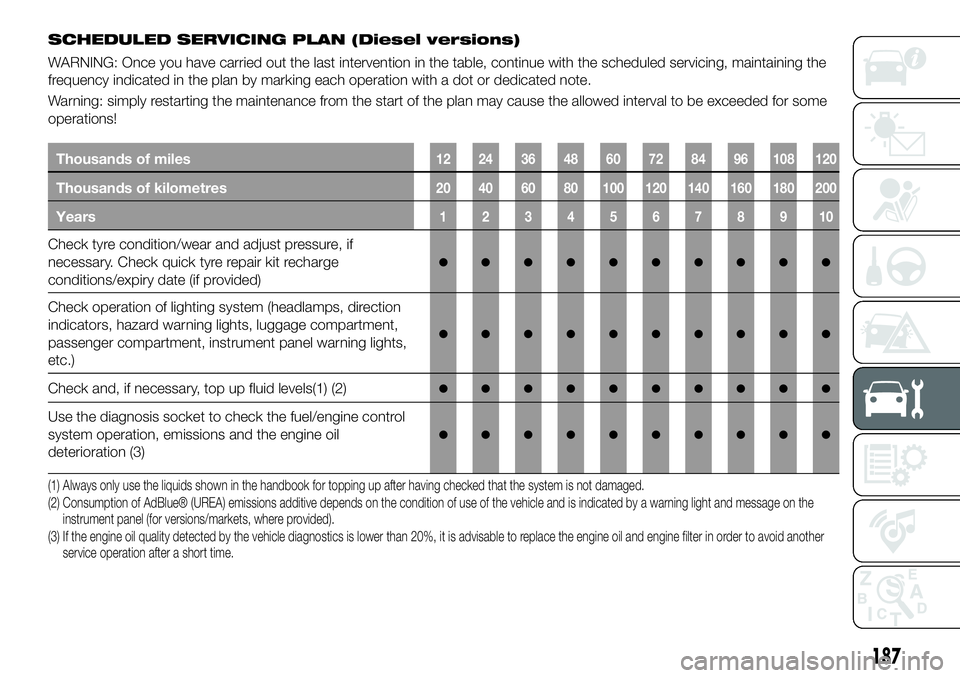
SCHEDULED SERVICING PLAN (Diesel versions)
WARNING: Once you have carried out the last intervention in the table, continue with the scheduled servicing, maintaining the
frequency indicated in the plan by marking each operation with a dot or dedicated note.
Warning: simply restarting the maintenance from the start of the plan may cause the allowed interval to be exceeded for some
operations!
Thousands of miles12 24 36 48 60 72 84 96 108 120
Thousands of kilometres20 40 60 80 100 120 140 160 180 200
Years12345678910
Check tyre condition/wear and adjust pressure, if
necessary. Check quick tyre repair kit recharge
conditions/expiry date (if provided)
●●●●●●●●●●
Check operation of lighting system (headlamps, direction
indicators, hazard warning lights, luggage compartment,
passenger compartment, instrument panel warning lights,
etc.)
●●●●●●●●●●
Check and, if necessary, top up fluid levels(1) (2)●●●●●●●●●●
Use the diagnosis socket to check the fuel/engine control
system operation, emissions and the engine oil
deterioration (3)
●●●●●●●●●●
(1) Always only use the liquids shown in the handbook for topping up after having checked that the system is not damaged.
(2) Consumption of AdBlue® (UREA) emissions additive depends on the condition of use of the vehicle and is indicated by a warning light and message on the
instrument panel (for versions/markets, where provided).
(3) If the engine oil quality detected by the vehicle diagnostics is lower than 20%, it is advisable to replace the engine oil and engine filter in order to avoid another
service operation after a short time.
187
Page 193 of 284
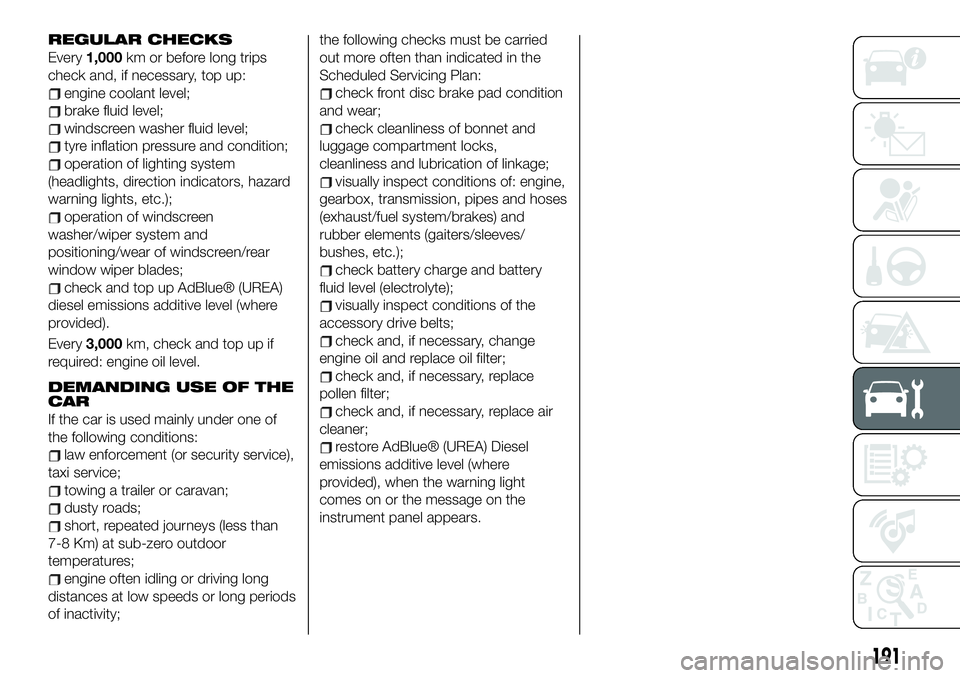
REGULAR CHECKS
Every1,000km or before long trips
check and, if necessary, top up:
engine coolant level;
brake fluid level;
windscreen washer fluid level;
tyre inflation pressure and condition;
operation of lighting system
(headlights, direction indicators, hazard
warning lights, etc.);
operation of windscreen
washer/wiper system and
positioning/wear of windscreen/rear
window wiper blades;
check and top up AdBlue® (UREA)
diesel emissions additive level (where
provided).
Every3,000km, check and top up if
required: engine oil level.
DEMANDING USE OF THE
CAR
If the car is used mainly under one of
the following conditions:
law enforcement (or security service),
taxi service;
towing a trailer or caravan;
dusty roads;
short, repeated journeys (less than
7-8 Km) at sub-zero outdoor
temperatures;
engine often idling or driving long
distances at low speeds or long periods
of inactivity;the following checks must be carried
out more often than indicated in the
Scheduled Servicing Plan:
check front disc brake pad condition
and wear;
check cleanliness of bonnet and
luggage compartment locks,
cleanliness and lubrication of linkage;
visually inspect conditions of: engine,
gearbox, transmission, pipes and hoses
(exhaust/fuel system/brakes) and
rubber elements (gaiters/sleeves/
bushes, etc.);
check battery charge and battery
fluid level (electrolyte);
visually inspect conditions of the
accessory drive belts;
check and, if necessary, change
engine oil and replace oil filter;
check and, if necessary, replace
pollen filter;
check and, if necessary, replace air
cleaner;
restore AdBlue® (UREA) Diesel
emissions additive level (where
provided), when the warning light
comes on or the message on the
instrument panel appears.
191
Page 280 of 284
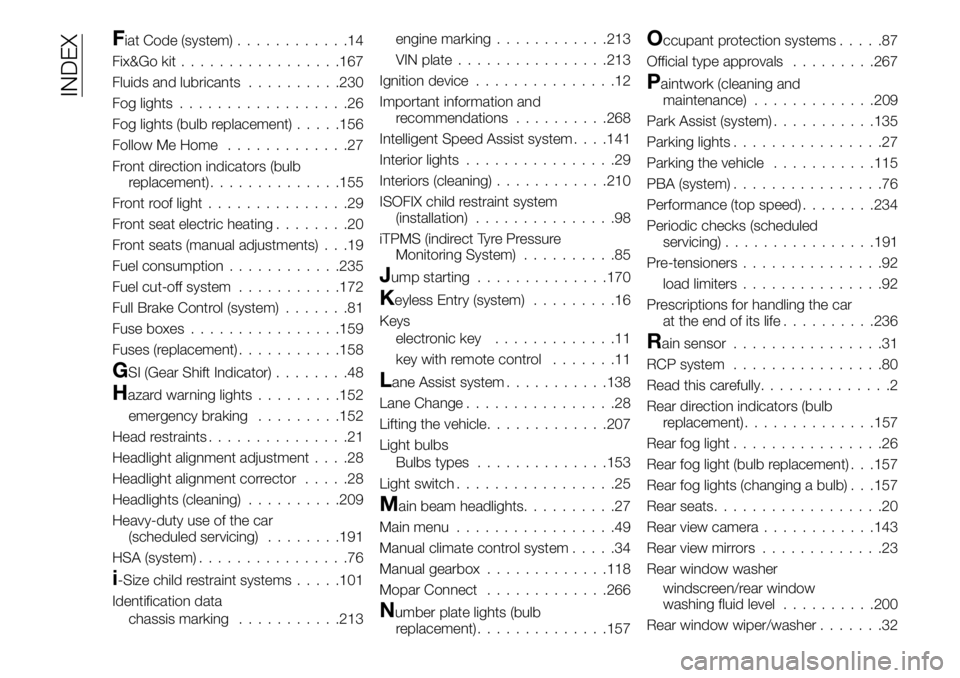
Fiat Code (system)............14
Fix&Go kit.................167
Fluids and lubricants..........230
Fog lights..................26
Fog lights (bulb replacement).....156
Follow Me Home.............27
Front direction indicators (bulb
replacement)..............155
Front roof light...............29
Front seat electric heating........20
Front seats (manual adjustments) . . .19
Fuel consumption............235
Fuel cut-off system...........172
Full Brake Control (system).......81
Fuse boxes................159
Fuses (replacement)...........158
GSI (Gear Shift Indicator)........48
Hazard warning lights.........152
emergency braking.........152
Head restraints...............21
Headlight alignment adjustment....28
Headlight alignment corrector.....28
Headlights (cleaning)..........209
Heavy-duty use of the car
(scheduled servicing)........191
HSA (system)................76
i-Size child restraint systems.....101
Identification data
chassis marking...........213engine marking............213
VIN plate................213
Ignition device...............12
Important information and
recommendations..........268
Intelligent Speed Assist system. . . .141
Interior lights................29
Interiors (cleaning)............210
ISOFIX child restraint system
(installation)...............98
iTPMS (indirect Tyre Pressure
Monitoring System)..........85
Jump starting..............170
Keyless Entry (system).........16
Keys
electronic key.............11
key with remote control.......11
Lane Assist system...........138
Lane Change................28
Lifting the vehicle.............207
Light bulbs
Bulbs types..............153
Light switch.................25
Main beam headlights..........27
Main menu.................49
Manual climate control system.....34
Manual gearbox.............118
Mopar Connect.............266
Number plate lights (bulb
replacement)..............157
Occupant protection systems.....87
Official type approvals.........267
Paintwork (cleaning and
maintenance).............209
Park Assist (system)...........135
Parking lights................27
Parking the vehicle...........115
PBA (system)................76
Performance (top speed)........234
Periodic checks (scheduled
servicing)................191
Pre-tensioners...............92
load limiters...............92
Prescriptions for handling the car
at the end of its life..........236
Rain sensor................31
RCP system................80
Read this carefully..............2
Rear direction indicators (bulb
replacement)..............157
Rear fog light................26
Rear fog light (bulb replacement) . . .157
Rear fog lights (changing a bulb) . . .157
Rear seats..................20
Rear view camera............143
Rear view mirrors.............23
Rear window washer
windscreen/rear window
washing fluid level..........200
Rear window wiper/washer.......32
INDEX
Page 281 of 284
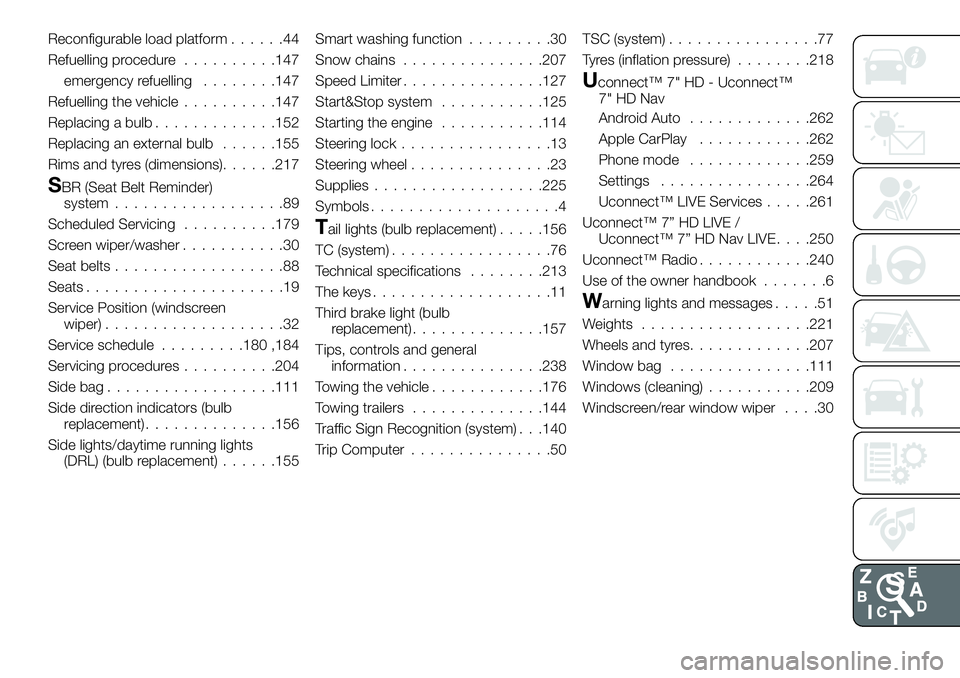
Reconfigurable load platform......44
Refuelling procedure..........147
emergency refuelling........147
Refuelling the vehicle..........147
Replacing a bulb.............152
Replacing an external bulb......155
Rims and tyres (dimensions)......217
SBR (Seat Belt Reminder)
system..................89
Scheduled Servicing..........179
Screen wiper/washer...........30
Seat belts..................88
Seats.....................19
Service Position (windscreen
wiper)...................32
Service schedule.........180 ,184
Servicing procedures..........204
Side bag..................111
Side direction indicators (bulb
replacement)..............156
Side lights/daytime running lights
(DRL) (bulb replacement)......155Smart washing function.........30
Snow chains...............207
Speed Limiter...............127
Start&Stop system...........125
Starting the engine...........114
Steering lock................13
Steering wheel...............23
Supplies..................225
Symbols....................4
Tail lights (bulb replacement).....156
TC (system).................76
Technical specifications........213
The keys...................11
Third brake light (bulb
replacement)..............157
Tips, controls and general
information...............238
Towing the vehicle............176
Towing trailers..............144
Traffic Sign Recognition (system) . . .140
Trip Computer...............50TSC (system)................77
Tyres (inflation pressure)........218
Uconnect™ 7" HD - Uconnect™
7" HD Nav
Android Auto.............262
Apple CarPlay............262
Phone mode.............259
Settings................264
Uconnect™ LIVE Services.....261
Uconnect™ 7” HD LIVE /
Uconnect™ 7” HD Nav LIVE. . . .250
Uconnect™ Radio............240
Use of the owner handbook.......6
Warning lights and messages.....51
Weights..................221
Wheels and tyres.............207
Window bag...............111
Windows (cleaning)...........209
Windscreen/rear window wiper....30